Use 'Print preview' to check the number of pages and printer settings.
Print functionality varies between browsers.
Printable page generated Friday, 26 April 2024, 6:57 PM
Study Session 6 Liquid Waste Management and Treatment
Introduction
Dealing with liquid wastes is one of the biggest challenges of urban sanitation. Liquid waste management requires capital investment, skilled personnel, coordination between different government departments and organisations, and awareness of the issues by the public. Failure to manage liquid wastes, especially human excreta, leads to health and environmental problems.
In urban Ethiopia the vast majority of people (80%) use pit latrines for human waste disposal (Central Statistical Agency, 2014). In some parts of Addis Ababa, liquid waste from waterborne toilet systems is collected via a sewerage system and sent to the wastewater treatment facility at Kality. There are, however, many houses and institutions with waterborne toilet systems that are not connected to the sewerage system. In these places, the sewage is sent to septic tanks. These different sanitation technologies require different techniques for managing and disposing of the wastes.
This study session looks at what happens to human excreta and other liquid wastes after they are produced. You will learn about the methods used to remove sludge from pits and septic tanks and about some of the options for managing and treating liquid wastes, including human excreta, sullage and stormwater.
Learning Outcomes for Study Session 6
When you have studied this session, you should be able to:
6.1 Define and use correctly all of the key words printed in bold. (SAQ 6.1)
6.2 Describe some options for the collection and transport of faecal sludge. (SAQ 6.2)
6.3 List the sources of faecal sludge, and how it can be treated and reused. (SAQ 6.3)
6.4 Describe the main methods for wastewater treatment and explain the differences between them. (SAQ 6.4)
6.5 Suggest a suitable means for sullage disposal. (SAQ 6.5)
6.6 Suggest appropriate methods for stormwater management. (SAQ 6.6)
6.1 Faecal sludge management
When human excreta collects in a pit latrine, the solids settle at the bottom and form a slurry called faecal sludge. Over time the sludge accumulates and periodically needs to be removed and disposed of. This process presents several challenges because the sludge is offensive, a potential danger to human health and highly polluting if dumped indiscriminately into the environment. Faecal sludge management (FSM) is a set of processes designed to ensure that people and the environment are protected from these hazards. It includes the storage, collection, transport, treatment and safe end use or disposal of faecal sludge (Strande et al., 2014). FSM is a significant problem in towns and cities in many developing countries. Key issues are who is responsible for collecting sludge and where and how it is disposed of.
The next section describes some of the methods for removing faecal sludge from pit latrines. These methods also apply to sludge removal from septic tanks, which are described in detail in Section 6.3.
6.2 Pit emptying
The process of pit emptying is sometimes called desludging. There are manual and mechanical methods for desludging, but the manual removal of faecal sludge from pit latrines poses severe risks to those undertaking the task.
What are the risks associated with manual emptying of pit latrines using buckets and shovels?
Firstly, there is risk of contact with faeces which could contain pathogens and cause disease. There could also be a danger of the pit collapsing if someone has to get inside to dig out the sludge.
Whether using manual or mechanical methods, the personal safety of anyone employed in pit emptying should be of primary importance. Operatives should wear gloves, masks and protective clothing.
6.2.1 Vacuum trucks
Vacuum trucks are vehicles equipped with a storage tank and pump with a hose that is lowered into the pit to suck the sludge up and out into the storage tank (Figure 6.1). The sludge can then be easily transported to a suitable disposal site. Vacuum trucks are quick, powerful and efficient, but they are large vehicles and so access to the pits can be a problem. The size of the truck can limit their use in areas where roads are narrow and twisting. Truck operators will charge a fee for their services, which is another factor that needs to be considered.
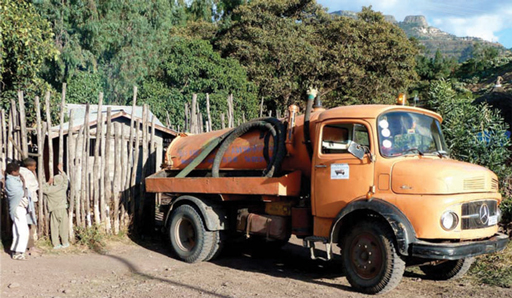
6.2.2 Vacutug
The Vacutug, shown in Figure 6.2, is basically a smaller version of the vacuum truck. It was devised by UN-Habitat as a system that could replace manual emptying. The Vacutug is a mechanical system that can be manufactured locally using readily available components. It is affordable, easily serviceable, able to operate in narrow passageways where vacuum trucks cannot go and is capable of sucking out waste sludge for transportation to a larger tanker vehicle (UN-Habitat, 2003). It can empty pits down to 2 m deep (Thye et al., 2009).
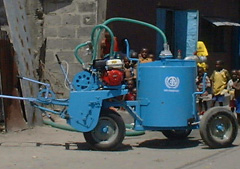
6.2.3 Hand-operated pumps
Even the Vacutug cannot get everywhere. The Sludge Gulper, like the one shown in Figure 6.3, is an example of a smaller hand-operated pump. These can be taken to pit latrines that are inaccessible to larger pumps. It is a simple design consisting of a PVC pipe containing two valves and can be built using locally available materials. The sludge is pumped up by hand, collected in a container and taken away for disposal. Care is needed to ensure that the operator and other helpers do not come into contact with the sludge and that it is not spilled.
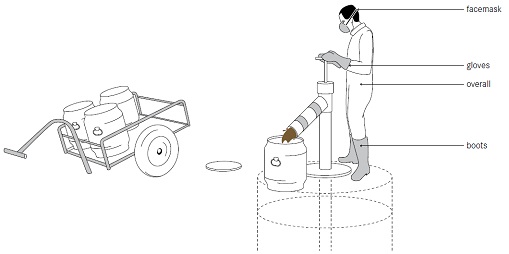
6.2.4 Disposal of the sludge
Several options are available for disposal of the collected sludge (Pickford and Shaw, 2005). It can be put directly onto land and used as a soil conditioner, but this is only possible if it has been left untouched for at least two years (Brikke and Bredero, 2003). Fresh, untreated wet sludge poses high risks for human health and so should not be put on land used to grow crops.
Drying the sludge will kill most pathogens. This can be achieved using drying beds (Figure 6.4), where sludge is put into shallow tanks to a depth of about 300 mm. The base of the tank is sloped and covered with a layer of sand (forming a ‘bed’) to allow liquid to drain out of the sludge. In the warm climate of Ethiopia and without rain, after about a week the sludge will be dry enough to be lifted by a shovel.
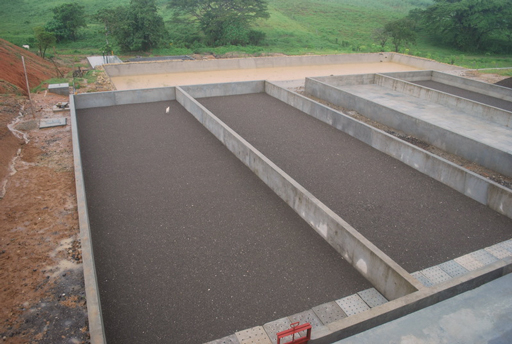
The sludge can also be composted by mixing it with vegetable matter, or biogas can be obtained by anaerobic digestion. Whichever method is used, faecal sludge disposal must be carefully managed and operated in order to ensure that the associated risks to health and the environment are avoided.
6.3 Septic tanks
A septic tank (Figure 6.5) is an underground and watertight tank made of concrete, fibreglass or PVC in which sewage is collected and partially treated. These are used for water-flushed systems that are not connected to a sewer. Concrete septic tanks are commonly used in Ethiopia.
What is sewage?
Sewage is combined wastewater from all sources and includes blackwater (human excreta), greywater and stormwater.
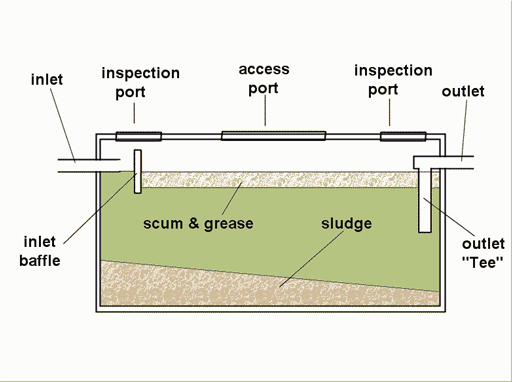
Wastewater enters the tank, remains there for a time, and is displaced out of the tank by new wastewater coming in. There are no pumps or mechanical parts. The time the wastewater remains in the tank is called the retention time and should be a minimum of 24 hours. In this period, the solid matter in the sewage settles to the bottom of the tank, where it is partially degraded by anaerobic micro-organisms.
The liquid above the sludge is relatively free of solids, but it does contain dissolved organic and inorganic chemicals that are not treated. Light substances such as oil and grease form a scum and float to the top. The position of the outlet (seen in Figure 6.5) ensures that only water from the middle of the tank is displaced outwards. This effluent is disposed of to a soakaway (also called a soak pit or seepage pit, Figure 6.6) or to a drainfield (Figure 6.7).
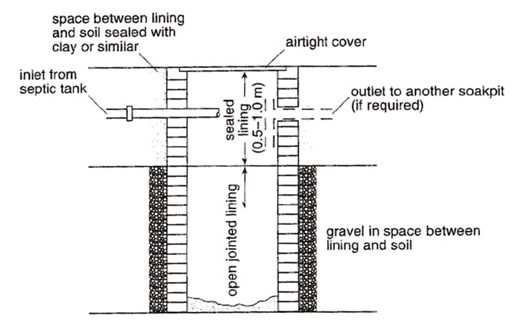
The soakaway is a covered, unsealed pit lined with bricks or stone. The wastewater from the septic tank seeps into the soil through the base of the pit and through the spaces in the lining material.
A drainfield (Figure 6.7) is a field where the effluent from a septic tank is disposed of. It can be constructed by laying a network of perforated pipes (pipes with tiny holes) in excavated soil which has a bed of gravel. Soil is placed over the top of the perforated pipe, and plants are grown on top of the drainfield. The wastewater is sent into the perforated pipe and percolates (seeps) through the gravel and goes into the ground, replenishing the groundwater.
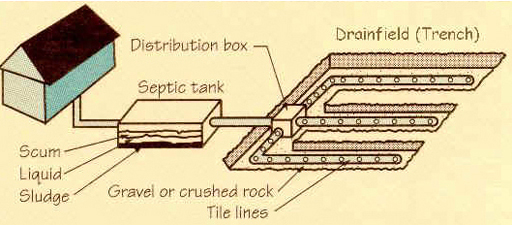
Septic tanks need to be desludged when the sludge depth is approximately two-thirds the depth of the tank. You can estimate this by putting a graduated stick into the tank. Depending on usage, this is typically once every 12 months. A vacuum truck is usually used to suck the sludge out for disposal (Figure 6.8).
If a sewer network is later installed in an area where there are septic tanks (as often happens in developing countries), the sewage flow can be connected directly to the sewer, thus bypassing the septic tank. This allows for better treatment (and possibly reuse) of the sewage, and of course eliminates the need for a septic tank.
6.4 Wastewater treatment options
Septic tanks remove solids from sewage, but treatment is minimal and the effluent contains high levels of dissolved organic matter and ammonia. Other options for better treatment are available.
The aim in wastewater treatment is to:
- reduce the amount of biodegradable material and solids
- remove toxic materials
- eliminate pathogenic micro-organisms.
There are several ways of treating sewage and other wastewaters with different costs and requirements. One that is particularly effective and economical in warm regions of the world is waste stabilisation ponds.
6.4.1 Waste stabilisation ponds
Waste stabilisation ponds are natural or constructed ponds used for treating sewage or other wastewaters biologically by harnessing the power of sunlight and wind. They are ideal for tropical countries like Ethiopia. The sewage collected by the sewerage network in Addis Ababa goes to waste stabilisation ponds at Kality.
In a typical waste stabilisation pond system, effluent that has passed through a screen is sent through a series of ponds (Figure 6.9) with a total retention time of between 10 and 50 days. Bacteria in the ponds degrade the organic waste and work symbiotically with algae, which provide oxygen through photosynthesis. (Symbiotically means in a relationship where two types of living organism live together for their mutual benefit.) Oxygenation also occurs through the action of wind and by diffusion from the air. No mechanical equipment is used in the ponds, so operation and maintenance costs are very low. Land requirement is, however, high.

The major part of the biodegradation of the sewage takes place in the facultative ponds. Facultative ponds are 1–1.5 m deep, with a retention time of between 5 and 30 days. In these ponds the upper layers are aerobic and the lower layers of water are anaerobic. Solids settle to the bottom and are anaerobically digested, so sludge removal is rarely needed.
Maturation ponds are placed after facultative ponds for the purpose of pathogen reduction (Figure 6.10). These are usually 0.5–1.5 m deep with a retention time of between 15 and 20 days. These ponds serve to inactivate pathogenic bacteria and viruses through the action of UV radiation from sunlight and the greater algal activity in these shallow ponds, which raises the pH above 8.5. (pH is a measure of acidity and alkalinity. It has a scale from 0–14: pH 7 is neutral, less than 7 is acid and more than 7 is alkaline.) The long retention time in the maturation ponds also enhances the sedimentation of the eggs of intestinal parasitic worms.
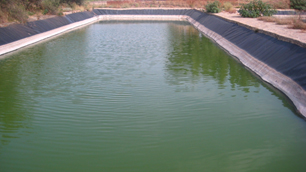
If the wastewater has a very high level of pollutants, anaerobic ponds can be used ahead of the facultative ponds. Anaerobic ponds are 2–5 m deep and are nearly devoid of oxygen. Their retention time is one to seven days. Solids settle to the bottom, forming a sludge, and anaerobic digestion takes place, producing methane. Up to 60% of the organic material can be removed in this process (Tilley et al., 2014).
To prevent sewage from leaching away, and to preserve the effluent for reuse later, the ponds should have a liner. This can be made of clay, asphalt, compacted earth or any other impermeable material (material that does not let fluid pass through). To prevent run-off from entering the ponds and to prevent erosion, a protective raised earth barrier can be constructed around the ponds using the excavated material from their construction. Finally, a fence is needed to keep people and animals out (Tilley et al., 2014).
Any scum that builds up on the surface of the facultative and maturation ponds should be removed to allow sunlight to reach all the algae and also to increase surface aeration. Large plants that are present in the water should be removed.
Treated sewage can be reused in crop irrigation if safe limits of faecal bacteria and intestinal parasite eggs are achieved in the treatment process. At the same time as treating wastewater, pond systems have been used to increase protein production through the rearing of fish (such as Tilapia) and ducks in maturation ponds.
6.4.2 Reed beds
Reed beds, or artificially constructed wetlands with emergent plants, have been used to treat sewage in many parts of the world. In Ethiopia, studies have been carried out on this type of wastewater treatment system for domestic wastewaters in Addis Ababa (Genet, 2007) and Kombolcha (Sahu and Yimer, 2014), and brewery effluent in Addis Ababa (Angassa, 2011).
Reed beds are ideal for warm countries where plants grow rapidly. They have low operational costs but they do require a lot of land.
The plants (usually reed species Phragmites australis or Phragmites communis) are grown in rows in beds of soil or gravel lined with an impermeable clay or synthetic liner (Figure 6.11). The effluent requiring treatment is fed into the bed, which typically has a depth of 600 mm. The base of the reed bed has a slope to enable collection of the effluent after treatment.
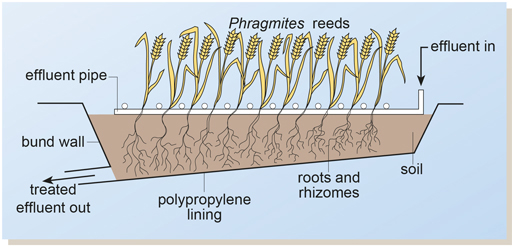
The effluent is distributed through pipes and nozzles onto the reed bed and then percolates down to the roots and rhizomes (horizontal underground stems) of the reeds. The root and rhizome system provides a mix of aerobic and anaerobic conditions that encourage a diversity of microbial species in the soil. As a result, the reed bed system has potential for treating a wide range of pollutants. For example, although micro-organisms that are capable of biodegrading many synthetic chemicals (such as some common pesticides) are found in soil, they not normally present in effluent treatment plants, so reed beds can be effective for treating effluents that contain these types of chemicals.
Can you think of an additional advantage that reed beds offer?
Reed beds are very attractive to birds and thus increase the diversity of wildlife where they are constructed.
6.4.3 Mechanical-biological wastewater treatment
Wastewater treatment can be undertaken using a sequence of processes in a mechanical-biological system (Figure 6.12). This treatment is faster than using natural systems such as waste stabilisation ponds or reed beds and requires less space. These factors make it desirable for sewage treatment in towns with large populations where there is not enough land for natural systems. However, mechanical-biological systems are more expensive because of the equipment required and the need for skilled personnel to operate them.
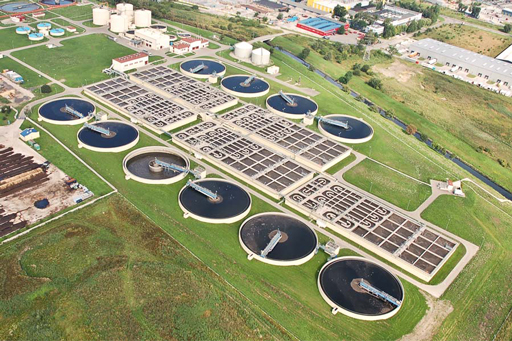
These systems typically have three main stages: preliminary, primary and secondary treatment.
Preliminary treatment
In this first stage screens (Figure 6.13) remove large items such as pieces of wood, metal, rags, paper or plastic that have got into the sewerage system. Removing them protects the structures and equipment in the wastewater treatment plant. Paper and rags in the wastewater flow are sometimes shredded by comminutors, which are rotating, slotted drums equipped with cutting blades. The shredded material can then be returned to the flow further downstream without causing harm.
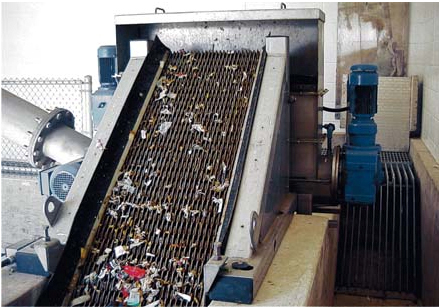
Small stones and grit have to be removed from the flow. Grit is comprised of very small pieces of sand, stone and possibly also glass and metal. All these materials can increase the rate of wear of mechanical equipment and can also settle easily in pipes, causing blockages. The grit settles out in grit channels (Figure 6.14) and can be removed daily by manual or mechanical means and dumped at a landfill site.
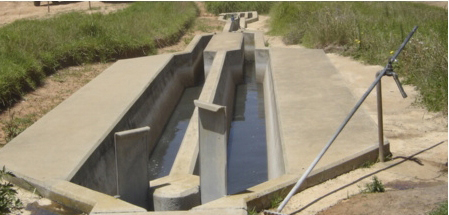
Primary treatment
In the primary treatment stage, fine solids in the wastewater are removed by settlement in a sedimentation tank (Figure 6.15). A properly designed and well-operated primary sedimentation tank will reduce the suspended solids content of the wastewater by between 50 and 70%, and the biochemical oxygen demand (BOD) by between 25 and 40% (Crites and Tchobanoglous, 1998).
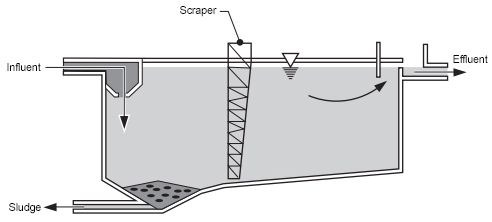
Secondary treatment
This is the biological stage of treatment. In secondary treatment the organic matter in the sewage is biodegraded by micro-organisms using oxygen. Oxygen levels are increased artificially by various means to ensure removal of organic matter. Also in this stage, ammonia in the sewage is converted to nitrate. This is followed by a second sedimentation stage to remove solids produced by the microbial activity. The treated effluent should be clear, free of pathogens and safe to discharge into a river or possibly be reused for irrigation.
6.5 Sullage management
What is ‘sullage’?
Described in Study Session 4, sullage is water that doesn’t contain any faecal matter or urine. Typically, it is wastewater that is produced from washing ourselves, washing clothes and from food preparation.
Many people simply throw sullage onto the ground or into the street. In small quantities this may be acceptable, but in densely populated urban areas proper handling and disposal is required. Some of the disadvantages of improper disposal of sullage include the potential to contaminate the soil, pollute water sources and create favourable breeding conditions for disease vectors.
Which vectors do you think might be encouraged by sullage collecting on the ground?
Mosquitoes are likely to be attracted, as they use stagnant water as breeding sites. Flies and rats might also appear, because the sullage would be a source of drinking water for them.
Sullage can be discharged to sewers or septic tanks in areas where these facilities exist. Where they do not, it is necessary to construct a pit near the household to dispose of sullage properly (Figure 6.16). The pit should be filled with gravel or sand. A sullage pit keeps the wastewater in one place and encourages it to soak quickly into the ground.
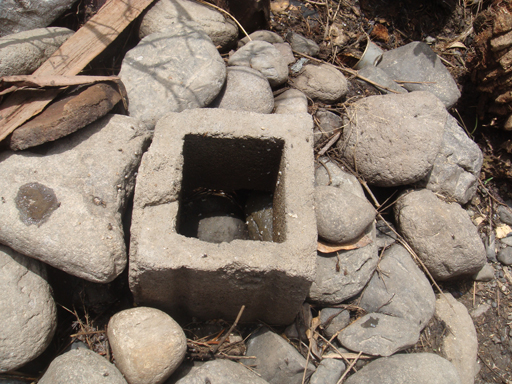
6.6 Stormwater management
In Study Session 4 you learned about the pollutants likely to be present in surface water run-off. What were they?
Faecal matter, soil, rubber from tyre wear, litter and oil from vehicles.
Stormwater has a polluting potential, as well as being a possible cause of flooding. In towns and cities, stormwater should be directed into stormwater drains (Figure 6.17). These should be kept clear of rubbish. Climate change means that many areas are experiencing heavy and prolonged rainfall, leading to flooding when the stormwater drains are unable to cope.
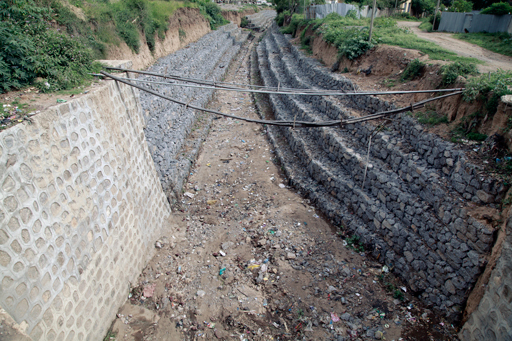
Sustainable drainage systems (SuDS) are an alternative to large storm drains. These systems include a range of techniques designed to reduce the speed of surface run-off, encourage infiltration into the ground and reduce the risk of flooding without the use of any mechanical equipment. Building ponds or holding areas in the drainage system so that storm water is temporarily stored and the speed of flow is reduced is one example. These storage ponds also make the water available for reuse. Another example is to encourage infiltration by using gravel or stones rather than solid concrete at the sides of roads (Figure 6.18). This reduces surface run-off and helps to replenish groundwater.
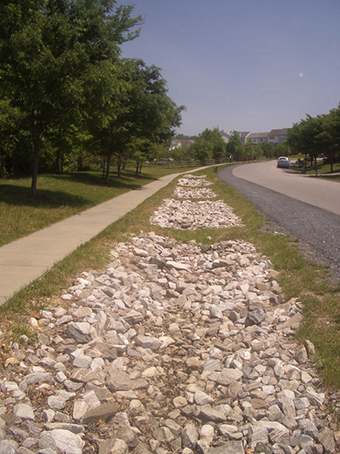
Summary of Study Session 6
In Study Session 6, you have learned that:
- Pit latrines are the most common method of disposing of human wastes in Ethiopia.
- Faecal sludge accumulates in pit latrines and septic tanks and must be regularly removed and disposed of safely.
- The sludge can be removed by various means, including vacuum truck, Vacutug or by manually operated pumps such as the Sludge Gulper.
- Sludge can be spread on land as a soil conditioner, but only after it has been treated to minimise health risks, for example by drying, composting or anaerobic digestion.
- Some water-borne toilet systems use septic tanks which hold wastewater for a minimum of 24 hours so that solids settle out. The effluent is discharged into the soil via a soakaway or drainfield. Septic tanks need to be desludged when approximately one-third full.
- The aims of wastewater treatment are to reduce the amount of biodegradable matter and solids in the effluent, remove toxic materials and eliminate pathogenic micro-organisms.
- Waste stabilisation ponds and reed beds use natural systems to treat wastewater and are suitable for warm countries. They do not need mechanical equipment and are thus low in operational costs but they both require a lot of land.
- Mechanical-biological wastewater treatment systems require less land than natural systems of wastewater treatment but they require equipment that makes them expensive to install and operate.
- Sullage should be discharged to sewers or septic tanks. If these are not available, it should be discharged into a pit filled with gravel or sand.
- Stormwater can be managed by sustainable drainage systems.
Self-Assessment Questions (SAQs) for Study Session 6
Now that you have completed this study session, you can assess how well you have achieved its Learning Outcomes by answering these questions.
SAQ 6.1 (tests Learning Outcome 6.1)
Match the following words to their correct definitions.
Using the following two lists, match each numbered item with the correct letter.
drainfield
Sludge Gulper
anaerobic ponds
septic tank
facultative ponds
comminutors
Vacutug
soakaway
maturation ponds
retention time
desludging
sustainable drainage systems
faecal sludge management
a.a watertight tank installed underground that collects sewage in areas where there are no sewers
b.ponds that are used at the end of a waste stabilisation system to reduce the level of pathogens in the wastewater
c.drainage systems that encourage infiltration of rainwater without special equipment
d.a network of perforated pipes through which the outflow from a septic tank goes into the ground
e.a small vacuum truck designed for pit latrine emptying in crowded areas
f.ponds that have oxygen at the top and no oxygen at the bottom
g.a manually operated pump for desludging pit latrines
h.first stage of waste stabilisation pond system treating highly polluted wastewater
i.an item of equipment that is used to cut up paper and rags in wastewater flowing into a treatment plant
j.combined processes for safely disposing of sludge from pit latrines and septic tanks
k.the process of removing sludge from a place
l.a pit into which the wastewater from a septic tank goes for disposal
m.the time that is spent in a given environment
- 1 = d
- 2 = g
- 3 = h
- 4 = a
- 5 = f
- 6 = i
- 7 = e
- 8 = l
- 9 = b
- 10 = m
- 11 = k
- 12 = c
- 13 = j
SAQ 6.2 (tests Learning Outcome 6.2)
Outline the main advantages and disadvantages of vacuum trucks, the Vacutug and the Sludge Gulper as options for pit emptying.
Answer
Vacuum trucks are quick and efficient, but because they are large vehicles are not suitable in some urban areas where roads and passageways are too narrow for them. Vacutugs are smaller and therefore can access places that trucks cannot reach. In places with very limited space a Sludge Gulper or similar hand-operated pump may be a better option. These are very simple tools, but it may be difficult to ensure the safety of the operator and effective containment of sludge throughout the process.
SAQ 6.3 (tests Learning Outcome 6.3)
- a.List the points where sludge is produced in the different treatment processes described in this study session.
- b.State briefly the options for treatment and reuse of the sludge.
Answer
- a.Sludge is found in pit latrines, septic tanks, anaerobic ponds in waste stabilisation pond systems, and in primary and secondary sedimentation tanks in mechanical-biological treatment plants.
- b.Some options for treatment and reuse are:
- direct application onto land as a soil conditioner after two years of storage
- drying out the sludge
- composting the sludge with vegetable matter
- anaerobically digesting the sludge to produce biogas.
SAQ 6.4 (tests Learning Outcome 6.4)
The table below has several statements applicable to different wastewater treatment systems. Allocate each of them to one of the following wastewater treatment options:
- Septic tank
- Waste stabilisation ponds
- Reed beds
- Mechanical-biological treatment.
| Is expensive due to tanks and equipment involved | |
| Can be used to treat wastewaters containing pesticides | |
| Relies on sunlight and wind for treatment | |
| Need a lot of space | |
| Requires skilled personnel for operation | |
| Used for houses with water-flushed toilets in areas without sewers | |
| The area around the roots and rhizomes contains aerobic and anaerobic bacteria | |
| A vacuum truck is used to suck sludge out of it | |
| Consists of many different stages of treatment | |
| Partially treated wastewater goes to a soakaway or drainfield | |
| A symbiotic relationship exists between the bacteria and algae in this system | |
| Use plants for treatment of sewage |
Answer
| Is expensive due to tanks and equipment involved | Mechanical-biological treatment |
| Can be used to treat wastewaters containing pesticides | Reed beds |
| Relies on sunlight and wind for treatment | Waste stabilisation ponds |
| Need a lot of space | Waste stabilisation ponds |
| Requires skilled personnel for operation | Mechanical-biological treatment |
| Used for houses with water-flushed toilets in areas without sewers | Septic tank |
| The area around the roots and rhizomes contains aerobic and anaerobic bacteria | Reed beds |
| A vacuum truck is used to suck sludge out of it | Septic tank |
| Consists of many different stages of treatment | Mechanical-biological treatment |
| Partially treated wastewater goes to a soakaway or drainfield | Septic tank |
| A symbiotic relationship exists between the bacteria and algae in this system | Waste stabilisation ponds |
| Use plants for treatment of sewage | Reed beds |
SAQ 6.5 (tests Learning Outcome 6.5)
You are walking in an alley in an unsewered part of town when you are nearly drenched by washwaters from clothes washing thrown over a fence. What would you do to advise the householder about proper disposal of their wastewater?
Answer
After recovering from my shock, I would approach the house where the water came from and gently explain to the person who threw the water that it is not advisable to dispose of such waters (sullage) by throwing it away as they did because:
- an innocent person could get soaked with dirty water
- the washwaters on the ground could become a breeding place for mosquitoes, and flies and rats could also be attracted to it as a water source
- the washwaters would make the alleyway wet and unpleasant.
I would suggest that the best way to dispose of the sullage would be to pour it into a hole that has had gravel or sand put into it.
SAQ 6.6 (tests Learning Outcome 6.6)
Name three ways in which the risk of flooding from stormwater can be reduced.
Answer
Flood risk can be reduced by
- building storm drains that are large enough to cope with large volumes of water
- constructing ponds that will temporarily hold the stormwater
- using broken stones and gravel rather than solid concrete in roadside ditches and other places where rainwater builds up so that water can infiltrate into the ground.
